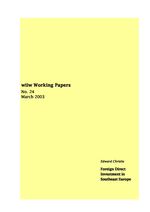Foreign Direct Investment in Southeast Europe
This paper applies a gravity model to foreign direct investment (FDI) stocks in five countries of Southeast Europe from nine selected Western European source countries, using five countries of Central Europe as a control group. Basic elements of the economic theory on FDI are shortly reviewed, then the discussion shifts to recent empirical work and the various issues surrounding estimates using the gravity equation.
FDI to Central Europe is mainly of the horizontal, market-seeking type. The evidence for Southeast Europe is less clear. Both types co-exist and, if we exclude Croatia, we are led to conclude that neither the vertical, efficiency-seeking type nor the horizontal type dominates. The countries of Southeast Europe overall are found, unsurprisingly, to have lower than normal stocks of FDI in relation to the countries of the control group, GDPs and geographical distances to investing countries accounted for. Through the estimation of a gravity equation for trade using the residuals of the FDI gravity equation, evidence is found in favour of complementarity, rather than substitutability, between trade and FDI for the control group. No conclusive evidence is found in favour of either for the countries of Southeast Europe.
Keywords: foreign direct investment, gravity model, Southeast Europe, proximity-concentration trade-off, economic geography
JEL classification: F21, F23, P17
Countries covered: Bosnia and Herzegovina, Bulgaria, Croatia, North Macedonia, Romania, SEE
Research Areas: International Trade, Competitiveness and FDI
